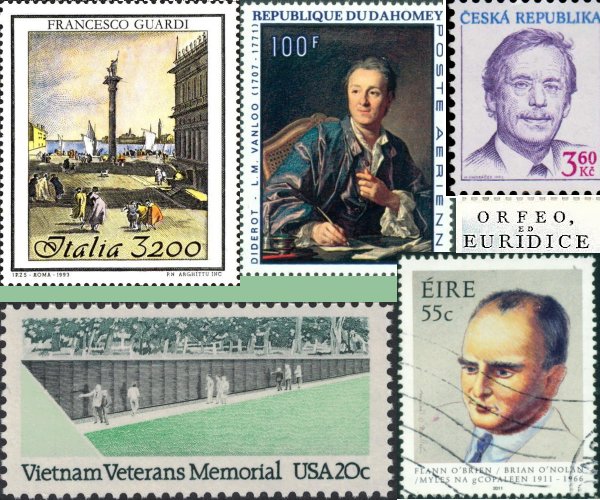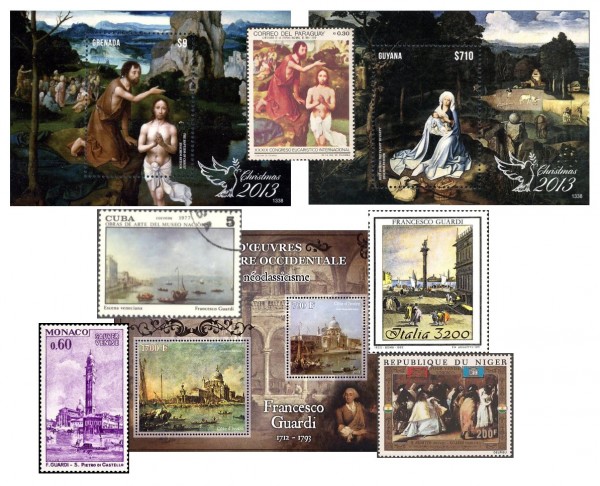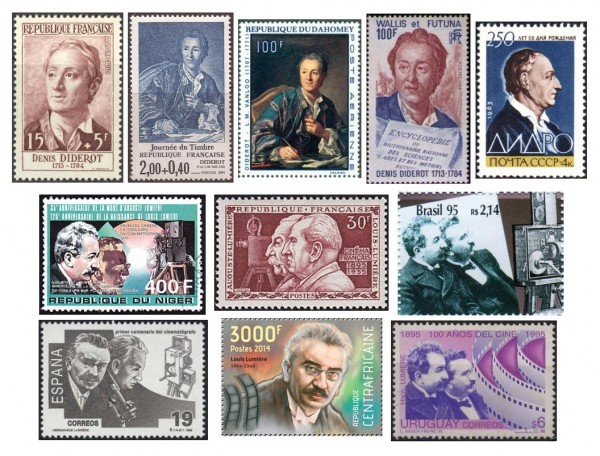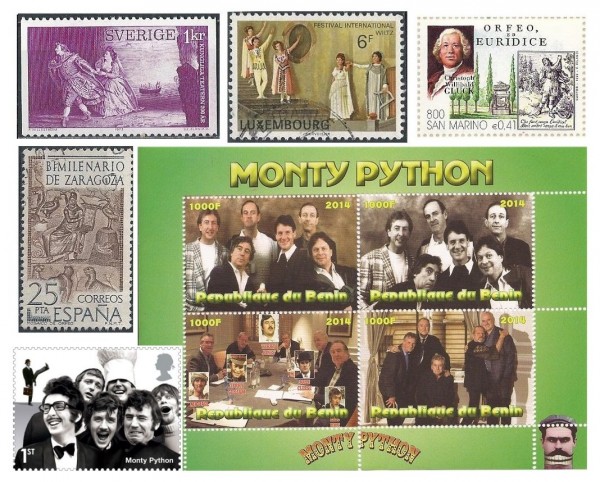The Arts on Stamps of the World —October 5
An Arts Fuse regular feature: the arts on stamps of the world.

By Doug Briscoe
Among our tributes today are those for Francesco Guardi, Denis Diderot, Václav Havel, Maya Lin, and Kate Winslet. Along with a half dozen other October 5 birthday salutes, we celebrate two anniversaries.
But we start with the Flemish Renaissance painter active in Antwerp Joachim Patinir, who died on this date in 1524. Born around 1480, Patenir was perhaps the first Flemish painter to think of himself as specializing in landscapes. He is credited with the invention of the “world landscape”, an imaginary panorama seen from a height, with any tiny human figures subordinate to their surroundings. One of the most famous succeeding practitioners of this style was Pieter Brueghel the Elder. He was a friend of both Albrecht Dürer and Quentin Metsys, with whom he often worked in tandem and who became the guardian of Patinir’s children after his death. One of their collaborations was The Temptation of St Anthony (1520), for which Patinir painted the landscape and Metsys the figures. Dürer, meanwhile, was a guest at Patinir’s wedding and drew a portrait of his friend in 1521. Two of Patinir’s works can be seen on stamps, The Baptism of Christ (1510-20) and The Rest During the Flight to Egypt (1518-20). (A variant of the latter also exists, dated 1515-24.) The two minisheets obviously had a common designer, though their provenances differ, one being from Grenada and the other from Guyana. The Paraguayan stamp connecting them shows a detail from The Baptism.
In yesterday’s article we saw that artist Francesco Fontebasso was somewhat indebted to Giovanni Battista Tiepolo. It so happens that today is the birthday of Tiepolo’s brother-in-law Francesco Guardi (October 5, 1712 – January 1, 1793), whose sister Maria Cecilia married the older painter. His father and brothers were also painters. A Venetian, Guardi in his younger days worked on religious paintings with his elder brother Gian Antonio; but after the death of his sibling Francesco turned to his métier, the veduta. Five examples of these are seen on the minisheet from the Côte d’Ivoire and stamps of Cuba, Monaco, and Italy. (In the lower right corner of the sheet is a portrait of Guardi by Pietro Longhi, whose birthday is a month and a day away.) The last Guardi stamp, less characteristic, is of The Foyer of the Palazzo Dandolo in San Moise frequented by masked revelers during Carnival season. Guardi’s son Giacomo (1764–1835) was also a painter.

Though best remembered for his exhaustive work on the magnificent Encyclopédie and as a philosopher, Denis Diderot (5 October 1713 – 31 July 1784) was also a playwright and art critic (his favorite contemporary painter was Jean-Baptiste Greuze). He was born in the Champagne and earned an MA in philosophy in 1732. After considering careers in the clergy and the law, Diderot opted for one as a writer. His father disowned him, and for nearly a decade he lived rather hand-to-mouth. He met Jean-Jacques Rousseau in 1742. The Encyclopédie, ou dictionnaire raisonné des sciences, des arts et des métiers (Encyclopaedia, or a Systematic Dictionary of the Sciences, Arts, and Crafts) was announced in 1745, with the first volume being published in 1751. Initially, Diderot was one of three editors, but the number was soon whittled down to two, the other being Jean le Rond d’Alembert. The project was inspired by the English Cyclopaedia, or an Universal Dictionary of Arts and Sciences of 1728 by Ephraim Chambers. Before long, however, trouble arose. The enterprise posed a threat to vested interests (church and aristocracy), as it promoted such subversive and noxious ideas as freedom of thought and the value of science. This and Diderot’s risqué novel The Indiscreet Jewels (Les bijoux indiscrets, 1748) earned him four months’ imprisonment in 1749. By 1758 D’Alembert had had enough and dropped out of the project, leaving Diderot on his own. The Encyclopédie was officially suppressed in 1759, though Diderot continued the work, his financial affairs suffering. When this came to the attention of Russia’s Catherine the Great in 1765 she bought Diderot’s library but asked him to maintain it for her for the time being, oh, with a librarian’s salary, naturally. (He visited the court in Saint Petersburg in 1773-74.) Altogether, Diderot devoted some twenty years of intensive labor to the Encyclopedia. His other notable creation, apart from some rather sentimental plays, was the philosophical dialogue Rameau’s Nephew, recalling Horace’s Satires. Diderot composed this in 1761-62 and revised it in 1773-74, but it did not see publication until twenty years after his death, and then in German translation (by Goethe, no less). When Diderot died, his heirs sent his huge library to Catherine the Great, who stored it at the National Library of Russia.
I want to acknowledge the birthday of Louis Lumière (5 October 1864 – 6 June 1948) without going overboard, either with text or pictures, although the number of stamps honoring him and his brother Auguste (1862–1954) is somewhere in the bajillions. The Lumière brothers were pioneers in motion pictures, but created no narrative films. Born in Besançon, the brothers’ inventions saved their father’s photographic portrait studio from bankruptcy. On his retirement in 1892 they began investigating the possibilities of moving pictures. The most significant of their numerous patents was one for the perforations in the sides of the film stock (though the idea had originated with Emile Reynaud). They lost interest in what they saw as a fad and moved on to other schemes, one of which was the first practical photographic color process, the Lumière Autochrome. I found Lumière stamps from Brazil, France, Macedonia, Mali, Monaco, Niger, Spain, Togo, Uruguay, and more. To show them all would require a full collage, so I picked and chose a few, because, after all, the Lumières weren’t Artistes! I include one from the Central African Republic that singles out Louis. (Maybe I’ll show a few more on Auguste’s birthday later this month.)
Another individual who gets a bit of a snub here is Louis Feinberg (October 5, 1902 – January 24, 1975), better known as Larry Fine of The Three Stooges. He was the odd man out in the sense that Moe, Curly, and Shemp were brothers (originally Horwitz). An interesting, if horrifying story about Louis is that as a small child he went to drink from a bottle of acid, and his father, who used the acid in his work, knocked the bottle from his hand. Unfortunately, the acid spilled onto Louis’ arm and caused severe damage. Louis took up the violin and then boxing as a means of strengthening his impaired forearm muscles. He took the violin into vaudeville and, from time to time, into the Stooges movies.

The important Irish postmodern novelist Brian O’Nolan (Ó Nualláin; 5 October 1911 – 1 April 1966) published his English-language works under the name Flann O’Brien. These include, most notably, his 1939 novel At Swim-Two-Birds, much admired by James Joyce, Graham Greene, Anthony Burgess, and Jorge Luis Borges. O’Brien attended University College, Dublin, writing prolifically in those years. He used many pseudonyms and produced stories, satires, articles, letters, and journalism.
I’ve always liked the English actor Donald Pleasence (5 October 1919 – 2 February 1995), so distinctively memorable in such roles as Ernst Stavro Blofeld in You Only Live Twice (in which guise he appears on a Congolese stamp) and Flight Lieutenant Colin Blythe in The Great Escape. Pleasence, born in Nottinghamshire, actually did serve in the RAF during the war and actually was shot down and held captive as a POW. (Initially, he had claimed conscientious objector status, but had a volte-face after the Luftwaffe began bombing London.) He flew sixty missions over Europe and while a POW produced and acted in plays. This he carried over into civilian life in repertory companies in Birmingham and Bristol. He made his television debut as early as 1946 and first appeared on American TV in an episode of The Twilight Zone. One of his most famous roles was as the psychiatrist Sam Loomis in the Halloween movies. He wrote a children’s book Scouse the Mouse in 1977, later narrated by Ringo Starr. Donald Pleasence married four times. My recommendation? The wonderful 1982 BBC TV miniseries The Barchester Chronicles (after Trollope), in which he starred as the Reverend Septimus Harding opposite his daughter Angela Pleasence.

It’s also the birthday of American cartoonist Bil Keane (October 5, 1922 – November 8, 2011), creator of the long-running newspaper comic The Family Circus. William Aloysius Keane was born in Philadelphia and, like Donald Pleasence, was a veteran of WWII, during which he drew and wrote for the Pacific edition of Stars and Stripes. The Family Circus first appeared on February 29, 1960 and, under the hand of Kean’s son Jeff, is still in syndication today.
Czech President Václav Havel (5 October 1936 – 18 December 2011) is seen, quite rightly, on any number of stamps from his country, but remembered more in his political capacity than in his life as a writer. For our purposes, of course, we focus on that aspect of his biography. He had the good fortune to be born into an intellectual family, his father a movie producer and his mother the daughter of a diplomat and journalist. Havel was first drawn to the theater, working behind the scenes. His very first play, apart from some early collaborations, The Garden Party (1963), was a success not only in Czechoslovakia but internationally, and his second, The Memorandum (1965), remains one of his most popular. That play was brought to New York in 1968 and introduced his work to the American theater-going public. 1968, of course, was the year of the Prague Spring, and his next plays, circulated secretly, established him as a dissident voice. He was repeatedly questioned by the police and imprisoned, once for nearly four years. As suggested above, I shall pass over his presidency of Czechoslovakia (1989-92) and of the succeeding Czech Republic (1993-2003). It was only after his retirement from politics that he returned to writing, first coming out with a memoir, To the Castle and Back (2007), and then in the same year his first play in nearly twenty years, Leaving. This was his last work apart from some shorter pieces. From the 1950s and 60s there are also a half dozen volumes of poetry.
Maya Lin (born October 5, 1959) is the American designer (she prefers “designer” to “architect”) who created the Vietnam Veterans Memorial in Washington, D.C. in 1982. She was only 21 and still an undergraduate at Yale when her design was chosen. Maya Lin, born in Athens, Ohio, is the daughter of a ceramist and former dean of the Ohio University College of Fine Arts (father) and a poet and literature professor at Ohio University (mother), both Chinese-born and resident in Ohio from the late 1940s. Other distinguished members of her family include her aunt the artist and poet Lin Huiyin, possibly the first woman architect in modern China, and her elder brother, the poet Tan Lin. Maya Lin’s submission for the Vietnam Memorial was chosen over 1,441 other entries. Lin believes her work would never have been chosen had not the competition been a “blind” one. Decriers objected to Lin’s Asian ethnicity—Ross Perot called her an “egg roll” (disgusting!)—as well as to her lack of experience and the unconventionality of the design. She said her idea was for the monument to simulate a wound in the earth. Of course, in the subsequent three and a half decades the monument has won the hearts of millions. It has twice figured on stamps of the United States, the first from 1984, just two years after the wall’s completion, and the second from 1999, part of the millennial series of sheets looking back over the decades of the 20th century. Some of Maya Lin’s later work are the Museum for African Art in New York (1992-93), the Langston Hughes Library in Clinton, Tennessee (1999), and, right here in Massachusetts, the Weber House in Williamstown (1991–93).

Two British film actresses share this October 5 birthday: Kate Winslet and Parminder Nagra, who both happen also to have been born in the same year, 1975. Winslet, of Reading, Berkshire, decided to study drama when she was 11 and appeared on TV in a commercial the next year. She made her proper television debut on the BBC children’s science fiction serial Dark Season in 1991. Since then, prominent roles have included parts in Sense and Sensibility and Kenneth Branagh’s Hamlet (both 1996) and Titanic (1997). Her image appears on stamps for the first (Antigua) and last (Guinea) of these. I’d like also to mention the fine Roman Polanski film Carnage (2011), partly for its quality but also because one of Winslet’s co-stars, along with Jodie Foster and John C. Reilly, was yesterday’s birthday subject Christoph Waltz.
Parminder Nagra, the daughter of Sikh immigrants from the Punjab, comes from Leicestershire. Her noted appearances have included Bend It Like Beckham (2002; see the stamp, on which she is paired with Keira Knightley), two popular NBC TV series: ER (2003-09) and The Blacklist (2013-14), and ABC’s Agents of S.H.I.E.L.D. (in a recurring role).
It was on the 5th of October that Gluck’s seminal masterpiece Orpheus and Euridice had its première in 1762; this was the original version in Italian (Orfeo ed Euridice), given in Vienna in the presence of the Empress Maria Theresa; his later revision, to a new French libretto (Orphée et Euridice), was given in Paris on August 2, 1774. (For those who may welcome a bit of assistance, English yoo-RID-i-see; Italian ay-oo-ree-DEE-chay; French er-ee-DEESS, more or less.) The opera has featured on a number of postage stamps: it was chosen for a design celebrating the bicentenary of the Royal Theater in Stockholm in 1973; for the 25th anniversary of the International Wiltz Festival in Luxembourg in 1977; and for the Gluck entry in a 1999 San Marino sheet of sixteen famous composers and their operas. For the heck of it I threw in a Spanish stamp that bears no connection to Gluck but depicts a Roman era mosaic of Orpheus—the floor (triclinium) mosaic dates from 2nd or early 3rd century Zaragosa (Saragossa, then known as Caesaraugusta).
It was on October 5, 1969 that another seminal event that marked all of us forever took place: the broadcast of the first episode of Monty Python’s Flying Circus on BBC One. The 2014 sheet from Benin depicts all six of the original members in the two stamps above, but only the five still surviving members on the bottom pair.
And while we’re in Britain, happy birthday to the fine writer Peter Ackroyd (born 5 October 1949).
A graduate of the University of Massachusetts with a B.A. in English, Doug Briscoe worked in Boston classical music radio, at WCRB, WGBH, and WBUR, for about 25 years, beginning in 1977. He has the curious distinction of having succeeded Robert J. Lurtsema twice, first as host of WGBH’s weekday morning classical music program in 1993, then as host of the weekend program when Robert J.’s health failed in 2000. Doug also wrote liner notes for several of the late Gunther Schuller’s GM Recordings releases as well as program notes for the Boston Classical Orchestra. For the past few years he’s been posting a Facebook “blog” of classical music on stamps of the world, which has now been expanded to encompass all the arts for The Arts Fuse.
